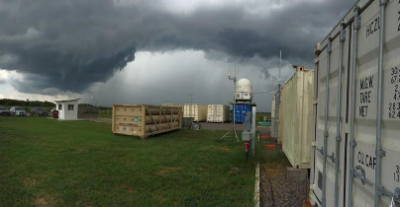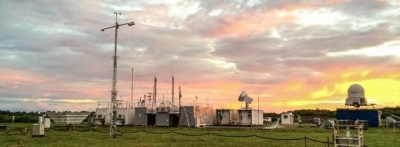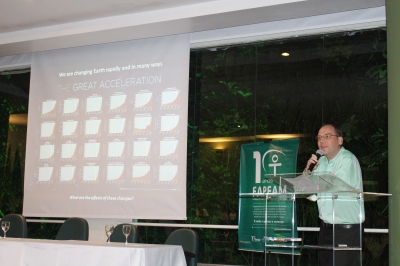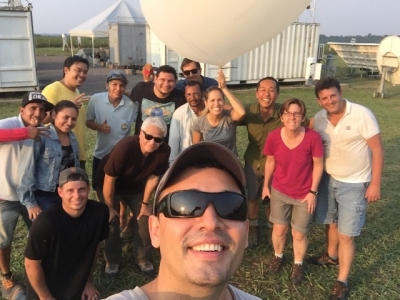Data help reveal urban impacts on the Amazon’s pristine atmosphere, precipitation, and cloud formation

Slogging through mud, Amon Haruta and Vagner Castro shielded sensitive climate instruments from the torrential rain. Working with colleagues in the heart of the Amazon, they shut down, dismantled, cleaned, and packed over a hundred instruments and containers from multiple facilities, shipping them down river. As the site returned to a pristine pasture, it appeared that the dense jungle swallowed up the operation; the dozens of international scientists and technicians a mere mirage.
It was here, west of Manaus, Brazil, that the crew retraced its complex steps taken two years prior to painstakingly assemble and launch the massive tropical research campaign called Green Ocean Amazon, or GoAmazon2014/15, a two-year international campaign with government and academic partners in the United States, Brazil, and Germany.
“Our team has closed operations at many locations around the world, yet this was one of the most successful closures ever. I was especially impressed by the hard work of our colleagues from Brazil’s National Institute of Amazonian Research (INPA). They did a fantastic job!” said Los Alamos National Laboratory’s Haruta, who managed the campaign’s pack up for the U.S. Department of Energy’s Atmospheric Radiation Measurement (ARM) Climate Research Facility.
Acquiring Data to Improve Models of Coupled Tropical Systems

The Amazon rain forest in Brazil is the largest forest in the world, covering about 1.7 billion acres and mostly uninhabited. Due to the sheer size of this rain forest, the area has a strong impact on the climate in the Southern Hemisphere.
The biology of this forest has a critical role in regulating atmospheric composition and climate over the region. Amazonian plants emit volatile organic compounds (VOCs) that react with other gases to form aerosols. These aerosols interact with the atmosphere to form clouds and affect solar radiation, and the aerosols also interact differently with the atmosphere than those from polluted parts of the world, where dust, smoke, and wildfires have a dissimilar chemistry. In addition, aerosol concentrations in the atmosphere are rapidly changing with deforestation and the associated biomass burning and economic development in the Amazon region.
Very little is known about these interactions and impacts, which inspired investigators to launch GoAmazon to capture rare data to fill gaps and support climate science.
The many collaborators placed instruments at various sites in Brazil’s Amazon Basin, which functions as a giant biogeochemical reactor to influence regional climate, and examined solar radiative energy, atmospheric moisture profiles, and clouds’ and aerosols’ microphysical and chemical properties. The ARM Aerial Facility and partner aircraft also monitored the region and gathered data from the pollution plume of Manaus—an incongruent metropolis of 2 million people—to investigate the flow of background air into Manaus, the emissions into the air over the city, and the advection of the pollution downwind of the city. This gives the researchers an important opportunity to compare a pristine environment with anthropogenically affected conditions.

“The observations of the GoAmazon2014/15 experiment show how the hydrologic cycle, radiation balance, and carbon recycling may be affected by present-day, as well as future economic development and pollution over the Amazonian tropical forest,” said Principal Investigator Scot Martin, a Harvard University environmental chemist. “This cooperative project employed an unparalleled suite of measurements.”
GoAmazon data will require some time for processing and analysis, but the wealth of information in the data set may help unravel the mysteries of how land and atmospheric processes affect tropical hydrology and climate, incorporated into climate-prediction computer models on which scientists and policymakers rely for future climate-related planning.
“Since the data have just finished being collected a few months ago, analysis is ongoing, and papers are just starting to be submitted. I would expect a lot more publications to come out over the next several years,” said Los Alamos scientist Allison Aiken, operations lead for ARM’s Mobile Aerosol Observing System deployed to the GoAmazon campaign. “There is currently work being done everywhere from small scale process studies to larger picture studies incorporating multiple sites that are already in the works using ARM MAOS data, which is exciting to see. As the scientific community becomes more aware of the depth of this data set, I expect there will be a lot more publications that take advantage of it since it is freely available to use through the ARM website.”
Brazilian Partners Vital to Campaign’s Success

A large team of ARM staff members and contractors worked for a month in the near-100-percent humidity and equivalent temperatures to perform post-deployment calibration and testing before beginning the detailed pack up of equipment.
Extraordinarily complex to begin with, the difficulty was compounded by the remoteness of the region.
On top of that, the 11 containers that contained the first ARM Mobile Facility (AMF1) components had to travel separately via multiple facilities in Florida, New York, Colorado, Virginia, and London before reaching the next destination. Components were shipped by air, ground, and sea, many taking a circuitous route before heading to Ascension Island in the middle of the Atlantic for ARM’s next AMF1 deployment, Layered Atlantic Smoke Interactions with Clouds (LASIC). And of course, instruments and chemicals had to be reconfigured to ensure they performed properly in climates that may differ greatly from Amazonia.
On January 16, closeout activities were completed and GoAmazon2014/15 was officially closed.
# # #
The ARM Climate Research Facility is a national scientific user facility funded through the U.S. Department of Energy’s Office of Science. The ARM Facility is operated by nine Department of Energy national laboratories, including Los Alamos National Laboratory. Los Alamos manages the first and second ARM Mobile Facilities.

